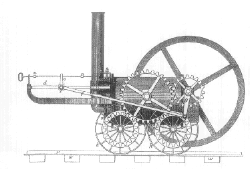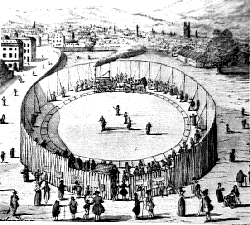Richard Trevithick -1776 -1837 -

Trevithick first locomotive - 1804 -
Richard Trevithick in England and Oliver Evans in USA were the first men that understood the importance of high-pressure steam.
Their (right) ideas were:
- Higher pressure;
- Higher speed;
- Lighter parts.
- Wider expansion stroke.
The first Trevithick high-pressure, double-acting steam engine worked a pump by a crossbeam in a Cornish mine in 1800.
Later, Trevithick built the steam engine that is called (please see the animation) the"Cornish engine". This engine was a great success, worked well for a long time.
It was a simple-acting and expansion engine, the steam pressure was 2,8-3,5 kg/cm² and let out the steam in a condenser.
In 1801 Trevithich built a steam-car with an inside hearth. It had a vertical cylinder and the piston moved the driving wheels by a crosshead.
Exhaust steam from the cylinder was directed up the smokestack to create a heavy draft for the boiler fire. This vehicle, which had no success, transported a lot of people, had a weight (full load) of 1520 kg and moved at a speed of 14,5 km an hour on the flat.
After having tested engines working with a steam pressure of 10 kg/cm², wich had never before been reached, Trevithick applied himself to the locomotive.
He hoped to move a peak load of 10 tons on a railway line 15 km long and with cast iron rail.
This first locomotive worked in 1804, and passed the test with full marks, transporting 25 tons at the speed of 6 km/hr.
Trevithick was thus the first locomotive maker.
With it Trevithick demonstrated (against the general scepticism) that a smooth wheel can move on a smooth track.
If Trevithick would patented his device to direct the exhaust steam from the cylinders to the smokestack (for a better draught) would conditioned the railway's development, as Watt, by the patent for the separated condenser, had dominated the field of the fixed steam engines.
It is probable that George Stephenson was inspired by Trevithick's works when he built his first locomotive in 1813.
At the beginning of the 19th century, Watt's patent expired and the use of the separated condenser became free.
This allowed other inventors to use their imaginations to the fullest.
Trevithick's works turned the manufacturers'attention toward the high pressure and multi-expansion steam engines.
Arthur Woolf, an engineer who had worked in Cornwall, was the first to build a multi-expansion engine (please see the animation). He built a two cylinders engine. The steam after having worked in the first at 3-4 kg/cm² was not let out, but was sent into the second larger cylinder. It worked by expansion until below atmospheric pressure (inside the condenser).
This engine worked more in France than in Britain.

First locomotive "Catch me who can"